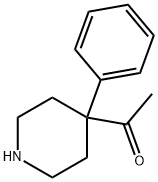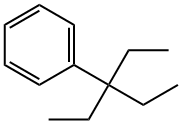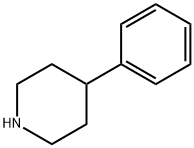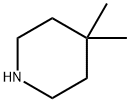4-ACETYL-4-PHENYLPIPERIDINE HYDROCHLORIDE
Synonym(s):1-(4-Phenyl-4-piperidinyl)-ethanone hydrochloride
- CAS NO.:10315-03-4
- Empirical Formula: C13H18ClNO
- Molecular Weight: 239.74
- MDL number: MFCD00039037
- EINECS: 233-694-0
- SAFETY DATA SHEET (SDS)
- Update Date: 2023-04-23 13:52:06

What is 4-ACETYL-4-PHENYLPIPERIDINE HYDROCHLORIDE?
Chemical properties
slightly yellow to beige powder
The Uses of 4-ACETYL-4-PHENYLPIPERIDINE HYDROCHLORIDE
Reactant for synthesis of neurotransmitter transport inhibitors with activity at dopamine receptor sites
General Description
4-Acetyl-4-phenylpiperidine hydrochloride generates acetylperoxyl radical via laser flash photolysis in the presence of oxygen.
Properties of 4-ACETYL-4-PHENYLPIPERIDINE HYDROCHLORIDE
| Melting point: | 232-234 °C(lit.) |
| solubility | water: soluble(lit.) |
| form | Powder |
| color | Slightly yellow to beige |
| Water Solubility | almost transparency |
| CAS DataBase Reference | 10315-03-4(CAS DataBase Reference) |
Safety information for 4-ACETYL-4-PHENYLPIPERIDINE HYDROCHLORIDE
| Signal word | Warning |
| Pictogram(s) |
 Exclamation Mark Irritant GHS07 |
| GHS Hazard Statements |
H317:Sensitisation, Skin H319:Serious eye damage/eye irritation |
| Precautionary Statement Codes |
P280:Wear protective gloves/protective clothing/eye protection/face protection. P305+P351+P338:IF IN EYES: Rinse cautiously with water for several minutes. Remove contact lenses, if present and easy to do. Continuerinsing. |
Computed Descriptors for 4-ACETYL-4-PHENYLPIPERIDINE HYDROCHLORIDE
New Products
Tert-butyl bis(2-chloroethyl)carbamate 4-Methylphenylacetic acid N-Boc-D-alaninol N-BOC-D/L-ALANINOL 3-Morpholino-1-(4-nitrophenyl)-5,6-dihydropyridin- 2(1H)-one Furan-2,5-Dicarboxylic Acid Tropic acid DIETHYL AMINOMALONATE HYDROCHLORIDE 1,1’-CARBONYLDIIMIDAZOLE R-2-BENZYLOXY PROPIONIC ACID 1,1’-CARBONYLDI (1,2-4 TRIAZOLE) N-METHYL INDAZOLE-3-CARBOXYLIC ACID (2-Hydroxyphenyl)acetonitrile 4-Bromopyrazole 5-BROMO-2CYANO PYRIDINE 5,6-Dimethoxyindanone 5-broMo-2-chloro-N-cyclopentylpyriMidin-4-aMine 2-(Cyanocyclohexyl)acetic acid 4-methoxy-3,5-dinitropyridine 2-aminopropyl benzoate hydrochloride 1-(4-(aminomethyl)benzyl)urea hydrochloride diethyl 2-(2-((tertbutoxycarbonyl)amino) ethyl)malonate tert-butyl 4- (ureidomethyl)benzylcarbamate Ethyl-2-chloro((4-methoxyphenyl)hydrazono)acetateRelated products of tetrahydrofuran








You may like
-
 4-Acetyl-4-phenylpiperidine hydrochloride, 99% CAS 10315-03-4View Details
4-Acetyl-4-phenylpiperidine hydrochloride, 99% CAS 10315-03-4View Details
10315-03-4 -
 4-Acetyl-4-phenylpiperidine Hydrochloride CAS 10315-03-4View Details
4-Acetyl-4-phenylpiperidine Hydrochloride CAS 10315-03-4View Details
10315-03-4 -
 1975-50-4 98%View Details
1975-50-4 98%View Details
1975-50-4 -
 2-HYDROXY BENZYL ALCOHOL 98%View Details
2-HYDROXY BENZYL ALCOHOL 98%View Details
90-01-7 -
 2-Chloro-1,3-Bis(Dimethylamino)Trimethinium Hexafluorophosphate 221615-75-4 98%View Details
2-Chloro-1,3-Bis(Dimethylamino)Trimethinium Hexafluorophosphate 221615-75-4 98%View Details
221615-75-4 -
 14714-50-2 (2-Hydroxyphenyl)acetonitrile 98+View Details
14714-50-2 (2-Hydroxyphenyl)acetonitrile 98+View Details
14714-50-2 -
 118753-70-1 98+View Details
118753-70-1 98+View Details
118753-70-1 -
 733039-20-8 5-broMo-2-chloro-N-cyclopentylpyriMidin-4-aMine 98+View Details
733039-20-8 5-broMo-2-chloro-N-cyclopentylpyriMidin-4-aMine 98+View Details
733039-20-8
Statement: All products displayed on this website are only used for non medical purposes such as industrial applications or scientific research, and cannot be used for clinical diagnosis or treatment of humans or animals. They are not medicinal or edible.